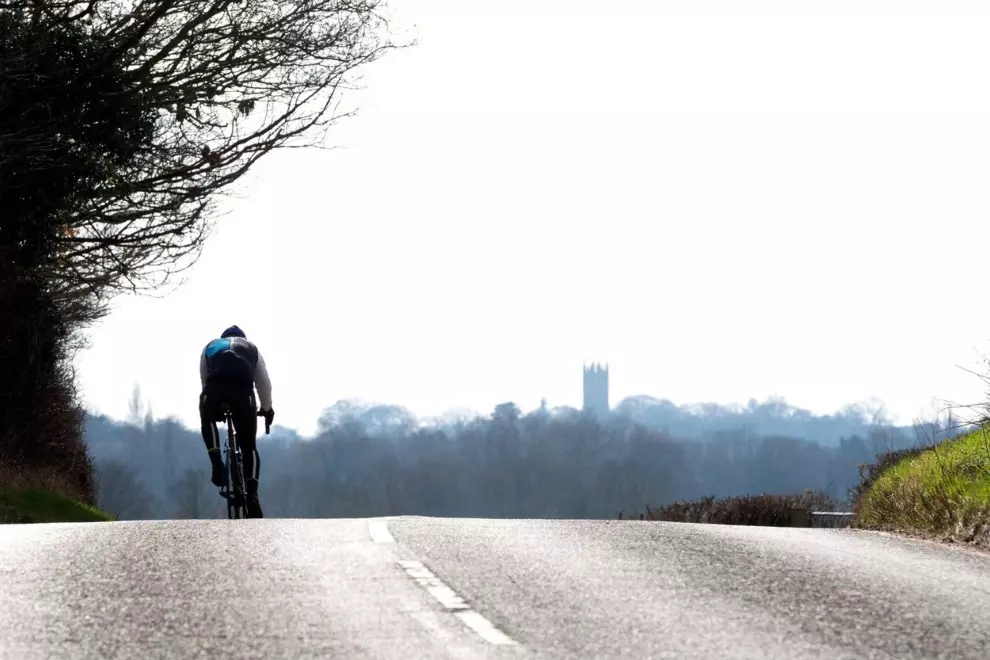It is ironic that the very thing that opened my eyes to cycling, that is, COVID-19, has been the first thing to enforce a prolonged period off the bike. Having only started riding during the first lockdown due to tennis courts being closed, I had always thought that if/when I contracted COVID-19 I would shake it off in a few weeks like most people my age and be back training in no-time.
While I was never terribly ill with COVID, its aftereffects stayed with me far longer than I’d hoped and, in this blog, I’d like to share my experience of the virus. I am not a doctor and so the things that I found worked for me isn’t medical advice, but I hope that it provides insight to anyone out there struggling with COVID’s prolonged effects.
Initially, I was following the standard return to play protocol set out by British Cycling. I completely lost my smell and taste for a week, had a cough, sore throat and a ‘blocked up’ feeling in my head. As these subsided, I attempted to ride at walking pace HR for short amounts of time; I managed this for a few days but then started to find my upper body was aching a lot and I felt really fatigued for things that were not normally tiring exercises.
I decided to head home for easier access to the GP and some parental support. I tried a lot of treatments; antibiotics for a possible secondary infection, as well as an inhaler prescribed by my GP, both to no avail. I was still trying to ride slowly at this point as I was convinced it was post-viral fatigue and doing a bit of very gentle exercise would be helping, but I found the opposite.
One ride in mid-August, I was barely pressing the pedals, my HR was through the roof and my chest was throbbing. I rang my brother in tears who was lovely, immediately cancelled all his plans and took me to A&E to get me checked out. My bloods (D dimer, Troponin, markers of infection, iron levels, full blood count, vitamins D, D12, folate and ferritin, my kidney, my liver, thyroid function test and calcium), ECG and chest X-ray were all clear, so after a not so short 8 hours at Wythenshawe hospital, I was sent home with no clear answers, but having ruled at least ruled some things out.
While I was there, I decided to get in touch with professional cyclist Lizzy Banks who is an ex-Storey Racing rider and who I met last year when she led the Škoda DSI Academy on a recce of the CICLE classic. For those of you not familiar with her story, I would encourage you to check out her Instagram or catch her on The Service Course podcast. She started racing late (aged 25) but worked her way up through the ranks into the World Tour and won stages of the Giro D’Italia (the biggest women’s stage race before the inaugural TDFF this year). However, after a nasty crash at Strade Bianche, she was out for the best part of the 2021 season with post-concussion syndrome. Just as she was back to race fitness, she tested positive for COVID-19 and has suffered with pericarditis and other complications. She is not the only professional athlete, or even cyclist to have this condition post COVID; Sarah Gegante, Tim Declerq and many other have had cardiac complications post COVID infection.
Lizzy was beyond helpful, and a lot of her symptoms seemed to match mine, which even though it doesn’t confirm we had the same problem, it at least gave me more of the right questions to ask to either confirm or deny what the issue could be. She gave me a lot of her time and some great advice, and I am extremely grateful for her help. She has recently started back training and her resilience through some tough situations has given me hope as I was struggling through my own.
Following my A&E visit, I decided it was best to follow Lizzy’s advice and steer clear of any exercise. I decided to give myself until mid-October (two months of barely walking or doing anything particularly stressful) before I would book in for a Cardiac MRI and see Dr Aneil Malhotra who is British Cycling’s Cardiologist. Unfortunately, the wait on the NHS for these kinds of tests is currently around 6 months so I was very fortunate to have the option to go private.
While my symptoms and energy levels did get better over this period of complete rest, I still wasn’t feeling like myself and upper body aches after exercise were still present, so I booked in for a consultation and scan. What it found was slight inflammation of the pericardium (sack of fluid around the heart), so I was prescribed some more rest and anti-inflammatories and then a gradual return to exercise. This gave me peace of mind that nothing else was wrong with me internally and that I had a plan for getting back to full health. After also having chest pain and elevated Troponin levels in February post my COVID booster and spending a weekend in A&E, I am happy to have reassurance that there are no cardiac contraindications for me returning to elite sport.
Fast forward a month and I’m now back to doing what I would class as ‘normal’ rides! I had been keeping off Strava as I had found it hard seeing the rides everyone else was doing when I was mostly just stuck inside. I started back just doing 10/15-minute rides, but I was scared to upload them in case I had a relapse of symptoms and was back at square one. My benchmark to start going public with again was when I could do the ‘Crawleyside Classic’ with no aches before, during or after and this was much sooner than expected! I have back dated my uploads since, so if anyone is interested in how I built up, please check it out here.
For anyone reading this who is struggling with COVID-19, here are some things I found helped me while I was still not feeling like myself:
REST
Doing absolutely NOTHING. As someone who has always thrived off having a goal and becoming pretty obsessed over it, being told to sit on the sofa, while some people’s ideal way to spend a few weeks, is my idea of torture. It is possibly the lowest I’ve felt, and I found it hard to stay positive and some days I didn’t manage it at all! However, relaxing and not doing much that was physically or mentally taxing was the biggest help in my recovery as my body’s ‘petrol tank’ was completely empty and needed time to fill back.
Keeping a symptom log
As a cyclist, I spend a up lot of time on Training Peaks (normally looking at my next training sessions or reviewing past ones) but with no training to do, I was instead using TP as a diary of sorts. When I was at my worst and low on energy, I also put to do lists in with small but achievable things, so I felt like I wasn’t ‘wasting’ the days where I was forced to rest. Looking back through this now, it’s helped me spot patterns in my symptoms and see just how far I’ve come (even if at the time, it didn’t feel like I was getting any better!).
Talking to people going through the same thing
I joined a Facebook group called ‘Long COVID for Endurance Athletes’ (over 2000 members of once fit and healthy people, a lot of whom are now struggling to be active at all) which had useful advice and some inspiring recovery stories from people further down the road from me. I reached out to tennis players I’ve known from my junior days and through university, and it’s really helped to get through a scary period where you’re completing doubting if your health will get back to where it was before.
Cold water therapy
This made a huge difference to my overall feeling throughout the day. I found the virus had left me feeling unexplainably anxious and the shock of a 3-minute cold shower and the release of serotonin after (much like the one I am missing from exercise) helped to relieve this anxiousness and allowed me to relax.
Meditation
I’ve never been one to meditate but with a lot of time in the day to fill, I decided to give it a go. I only put aside small portions (2-5 mins) of the day to train my mind to focus on nothing, just let thoughts pass through and not attach emotions to them, but I enjoyed trying something new and am trying to keep it as part of my routine. I hope it will also have the added benefit of improving my management of things like pre-race nerves!
Stretching
The one thing from my normal training routine I could still do. In the first few weeks of COVID, I found I was too lacking in energy to make my tired body stretch, but when I started to feel marginally better but still couldn’t ride, it made me feel like I was still a cyclist, which is something I’d missed while being off the bike.
Eating whole foods
With a lot more time spent around the house, I had more time to experiment with recipes and cook different meals. I tried to base them around fruit and veg but also made bread, jam and quite a lot of cake and ice cream to fuel Tom’s crazy rides!
I’m grateful for all the people who helped me through this period. The thought process that finally helped me dig myself out of the ‘mental bin’ I’d found myself in was that if I zoom out, I am still unbelievably privileged. I have amazing family, friends, qualifications and a job I love. Yes, in the moment, a big part of my life had been taken away, but now I have it back I am more appreciative than ever to be on two wheels.
Everyone gets dealt bad cards in life, but even the bad ones I’ve had dealt, in the grand scheme of things, have been pretty good so far.
If you are struggling through Covid and want someone to talk to, please get in touch. I’ve be overwhelmed by the kindness of people I’ve met through local bike shops, Strava, over Instagram and more; the kind words and advice have really kept me going, so if I can do that for anyone, I would really like to.
I hope to see you all out on the road soon. 😊





